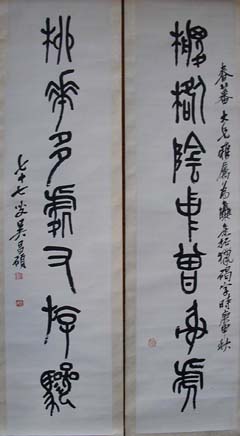| Art Q&A > Painting |
|
|
Great Painter and Engraver of Sea Painting School: Wu Changshuo
A native of Anji, Zhejiang Province of East China, Wu (1844-1927) had a poor childhood and developed interests in seal cutting under the guidance of his father. Due to the famine in his hometown, Wu experienced five years of vagrancy since the age of 17. Returning home, Wu taught himself poetry, calligraphy and seal cutting. Later, he founded the Xiling Seal-cutting Society and was elected president. At 29 Wu learned about the famous calligraphic works and paintings of his predecessors in Suzhou; in his 30s he learned to paint from Ren Bonian; and from his 30s to 50s, his artistic achievement reached its peak, and Wu finally became a master of art.
Wu Changshuo achieved
the highest standard in Xie Yi (free-style) flower painting, using a style greatly influenced by Xu Wei and
Ba Da. Due to his solid grounding in seal cutting, Wu introduced the technique
of using burin and calligraphy to his painting, creating a distinct style. Wu
painted the plum blossom and orchid in a similar way to writing seal characters
and painted grapes like wild cursive handwriting. Thus Wu's paintings were
considered magnificent and novel. As to the composition of his paintings, Wu was
especially fond of the |
||||||
All rights reserved. Reproduction of text for non-commercial purposes is permitted provided that both the source and author are acknowledged and a notifying email is sent to us. |
||||||
 |



